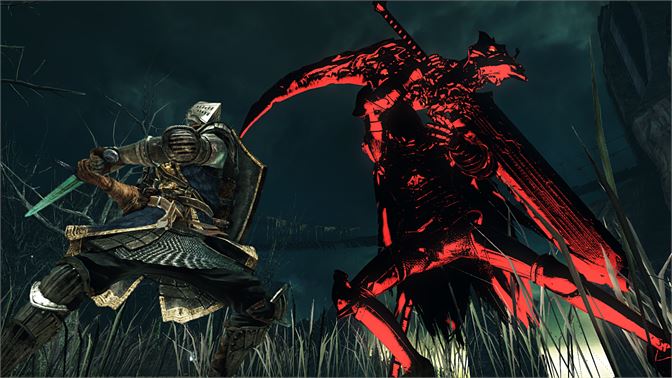Dark Souls, FromSoftware’s smash hit game featuring the biggest, nastiest bosses and the steepest learning curve since, well, ever, was always going to get a sequel. The question on everyone’s lips, or at least those of us who had suffered through the first game, was “will FromSoftware take it easy on us this time around?”. Well, the answer was a resounding no, so much so that one of the game’s directors, Yui Tanimura, is quoted as saying: “We do not plan on having an Easy Mode since we are creating this game with a thought that challenge and difficulty are core elements of the game”. So, pretty much business as usual then.

The original version of Dark Souls 2 was released on PS3, Xbox 360 and PC in March 2014, to a pretty good reception. However, the edition of the game that I’m looking back to here is the first of the series to make its debut on Microsoft’s shiny new Xbox One (as well as PS4, obviously) – Dark Souls 2: Scholar of the First Sin. A suitably doom-laden title for an oppressively difficult game, to be sure, including all of the previously available DLC as well as upgraded visuals, new online features if that was your bag and some slight tweaks to the storyline.
The storyline of the game is again, as it was in the first game, somewhat difficult to uncover, as Dark Souls 2 doesn’t do much of a job of explaining what is happening to you, or why. Basically, as far as I can make out, we were Human, in the beginning, but have now become Undead. Why and how isn’t clear, but what is a certainty is that our future holds nothing except becoming Hollow and losing what little humanity we have left, eventually becoming a zombie-like being with no memories, no purpose and, worst of all, no hope. To avoid this fate, we have to travel to the fallen kingdom of Drangleic, and as luck would have it the Emerald Herald is looking for a volunteer to slay four Old Ones and recover their Great Souls.
Once we have the Souls (and believe me, it is a lot easier to type this than actually do it) we are tasked with seeking the King of Drangleic. Instead we find the Queen, Nashandra, and she tells us that the King has fled the kingdom after failing in his duty. It turns out that Nashandra is a great big fibber, and for reasons that I’ll not go into in case you haven’t played it, we end up having to stop her instead. It’s here where the story becomes even more bonkers than usual, as the prospect of time travel is introduced and we are able to access the memories of dead bodies, allowing us to live through times long gone. Entering the memories of a dead Giant allows us to fight the Giant Lord and claim his power for our own, using that to sort out Nashandra once and for all. Then there comes the almost traditional choice at the end of Souls games – do we link the fires or take the power for ourselves and forge our own path?

There was one other change that was made to Dark Souls 2: Scholar of the First Sin that had a massive impact on the gameplay. If you died – and as this is a Souls game it was almost inevitable that you would – when you were resurrected or respawned your available health pool was cut in half. Think about what this means for a moment: if you are fighting a boss and it kills you, as is the most likely outcome, if you didn’t have any way of undoing this the next time you challenged the boss it would be with half health. And then less and less as you keep failing.
Thank goodness then that there was the ability to summon other people to your game world, to help take down the bosses still present and correct, as without it I – and many others – may have just given up with DS2 altogether. As it is, I instead ended up sacrificing a controller to this game, as after a bit of play (and maybe a few slam downs and one full tantrum toss) my controller seemed to develop a habit of moving my character when I wasn’t touching the left stick. The last straw came when I turned to talk to my wife, removing my hands from the controller, and it proceeded to walk my character off a cliff, losing the 50,000 souls I’d spent about 45 minutes of collecting. Many bad words were said and a new controller bought the next day. Fittingly, I’ve just broken this one playing The Surge 2 – maybe I’m just not cut out for these types of games.
The DLC that was included in the Scholar of the First Sin edition was The Lost Crowns, split into three parts on first release – The Crown of the Sunken King, Crown of the Old Iron King and finally The Ivory Crown. Each of these DLC packs adds a whole new area to the game, along with a very challenging path to the bosses of said areas. The best part about the Scholar of the First Sin version is that these areas are incorporated from the very beginning, and so you can go to them whenever you are ready.

Or whenever you are not ready, as my first trip to the Tower from the second DLC pack showed. As a relatively low-level player, I was roundly stomped by the inhabitants of this tower, and as the enemies here are designed to make you advance slowly and tactically a hasty retreat was needed and a lot of levelling required before I could hold my own. The design of these new areas is worthy of special mention too; complex and tricky to navigate, not to mention stuffed with enemies, traps and even enemies in traps. They really required you to have your wits about you.
These then are my memories of the brutal second instalment of the Dark Souls games, with Dark Souls 2: Scholar of the First Sin on Xbox One from 2015. But I want to know about you guys. Did you play it when it first came out, or are you looking for a challenge and fancy giving it a crack now? I can say that the difficulty hasn’t abated with the intervening years, and honestly I’d say this is the hardest game in the three main games of the Dark Souls series. Let us know your thoughts and memories in the comments.







